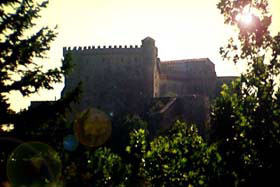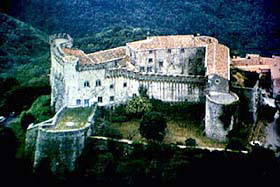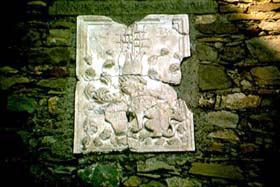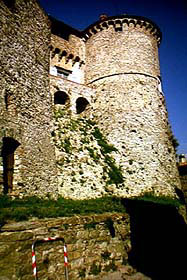Fosdinovo Castle
 |
 |
|
Two global views of the mighty castle.
|
|
Fosdinovo Castle dominates the homonymous suburb. It can easily be reached following the A12 Genoa-Leghorn until the 'Carrara' exit, from here the Aurelia road towards Sarzana until its innest with the SS446 that lead to Fosdinovo.
With its 12th century walls still intact, Fosdinovo Castle crowning a hill 550 meters high today still dominates a great part the Tyrrhenian coast line from its location ten kilometers inland where the Magra Valley opens to form a plain. The position was ideal to maintain control of the Apennines outlet to the sea and the Lunigiana region with its roads and mountain pass, between the most important roads linking the Tyrrhenian coast to northern Italy during the Middle Age.
 |
|
One of the coat of arms walled on the main gate walls.
|
From the year 1124 we have records of the existence of Fosdinovo Castle as fief of the Erberia family, posted under the direct control of the Luni's Bishop. This arrangement continued until the year 1317 when the overbearing rise of the marquises Malaspina, strictly tied with the Ghibelline cause, brought the Episcopal power over these lands to a rapid decline and the leader of the family Spinetta Malaspina took possesion of the castle. Immediately after Fosdinovo was conquered by the great captain Castruccio Castracani, gentlemen of Lucca, that besieged the castle with 6000 foot-soldiers and 1000 knights. After the decline of the fortunes of Castruccio the castle returned into the hands of the Malaspina in the year 1334.
 |
|
The front towards the town with one of the powerful
round towers.
|
At the beginning of the 14th century the Malaspina, now gentlemen of the entire Lunigiana thanks to the help of the powerful family of the Scaligeri of Verona and Enrico VII, moved the seat of the family from the nearby castle of the Verrucola of Fivizzano to Fosdinovo, and made the nearby town the administrative center of their lands, enlarging and reinforcing its castle. The original keep of the 12th century was widened with turrets and a cylindrical tower, ghibelline battlements with 'tail of swallow' form and machicoulis on the sides towards the Lunigiana and with powerful towers and bastions on the walls facing the little town; inside the castle became one of the finest noble residences of the time, full of frescoed rooms. The magnificent inner courtyard had a 16th century addition. Over the main gate, defended by a breteche, still present is a coat of arms that consists of a dog holding the thorn plant known as "Spino" in its mouth in memory of the strong ties between the Malaspina and the Scaligeri families. All around the walls we can noticed many gun loops for cannons and other fire arms.
The castle has the reputation of 'indestructible' and the earthquake of 1922, that destroyed great part of the area, resulted in no serious damage. A legend says that the great poet Dante Alighieri passed some days at the castle, an event historically impossible. Another legend is tied to the presence in one of the rooms of the castle of the 'well of oblivion': the marquise Cristina Adelaide Pallavicino, bride of Ippolito Malaspina, attracted her lovers into this room and then threw them down in this pitfall full of blades which ended in a water channel beyond the walls. Most likely the trap was used, but for the elimination of enemies! The castle is still owned by the marquises Torrigiani-Malaspina, and recently it underwent a major restoration and it's visitable only on appointment by a fee.
| More Photos |
| View the castle Map |
| Back to Homepage |
| Back to Castles Index |